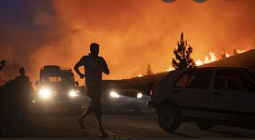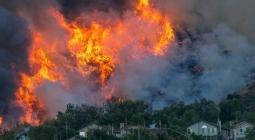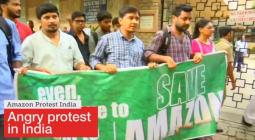It kills everything' - Amazon’s indigenous people hit by record forest fires in Brazil
“If these fires continue, we indigenous people will die.”
Raimundinha Rodrigues Da Sousa runs the voluntary fire service for the Caititu indigenous community in the Brazilian Amazon.
Their land is supposed to be protected under the Brazilian constitution.
But it has been on fire for more than 15 days.
For her brigade, their fight feels personal.
“Today it is killing the plants, in a while it will be us, because we inhale so much,” she says.
“It is a very aggressive fire that kills everything that comes its way.”
Her father, Ademar, tells us the constant smoke has caused him respiratory problems.
“I can’t sleep due to a lack of air. It wakes me up, I feel like I’m drowning,” he says.
The Amazon has had its worst forest fires in two decades. More than 62,000 square kilometres have been burned this year already – an area bigger than countries like Sri Lanka or Costa Rica.
The world relies on the Amazon to absorb a lot of its carbon. These fires mean it is now emitting record amounts itself.
Most fires here are illegally started by humans, according to scientists, the Federal Police, and the government: loggers and miners looking to exploit land in the Amazon, or farmers turning it into pasture.
It is much rarer for fires to occur naturally in the humid, tropical rainforest.
Many fires encroach on protected reserves or indigenous land, either by accidentally getting out of hand, or set by people as deliberate attempts to grab land.
Raimundinha says that when her brigade arrives at the scene of a fire, they often find bottles of gasoline and matches.
As she speaks, she spots another plume of smoke from some trees. She is certain it was started deliberately, as they’d only just extinguished the fires there and created a natural barrier to stop it spreading, by removing any dry vegetation from the area.
Her team go to investigate. As we get nearer, there is a distinctive smell of smoke.
The landscape on the way to the fire is like a graveyard of trees, collapsed and blackened in their entirety.
The rainforest here barely merits its name. The trees still standing are charred and warped like burnt matchsticks. The ground is coated in white powder like the remains of a barbecue.
Her team try to put out the flames with hoses they use to spray water, attached to small plastic containers they wear like backpacks. The water is limited, so they have to be selective.
The problem is, as soon as one is put out, another starts.
The indigenous chief, Ze Bajaga, says that the majority of these fires are arson, set by people who “no longer want the wellbeing of humanity, or nature”.
He blames a lack of “humanity”.
In recent years, deforestation has slowed in the Amazon. But despite attempted crackdowns by state authorities, lawlessness is still rife, and the state presence feels minimal.
Some of the Amazon is privately owned by individuals or companies. Private owners are meant to conserve 80% of the rainforest on their land by law, and can develop the remaining 20%. But this is not well policed.
Some of the land is classified as a state-owned protected reserve, or as an indigenous reserve. Some land though is undesignated entirely - meaning it is not privately owned by anyone, and has also not been protected as a reserve.
Those areas are particularly vulnerable to land-grabs. Everywhere you drive or fly over in the south of Amazonas state, mines, loggers and farms are visible.
Dorismar Luiz Baruffi, a soy farmer based in the Amazonas town of Humaitá, has owned his land for many years. He is against the fires, but can explain why farming has “exploded” in the Amazon.
At the heart of his, and others’, argument is the belief more land should be productive, not just protected.
“Growth of the population has increased planting up here. I started here because the region is good, it rains well here,” he explains.
“I believe if you’re working within the law, there’s no problem. It is a place that provides food. It is a state that can produce a lot. I think there is still a lot of land to be cultivated here in Amazonas.”
Deforestation is bad for farmers too though. The fewer trees there are, the less water vapour is emitted to create rain for their crops - which some farmers burn their land to make room for.
“We did poorly this year because of the drought,” he says.
The fires may be mostly started by humans, but they have been made worse by Brazil’s worst-ever drought, which has turned the normally damp vegetation into a dry tinderbox.
The drought has seen the level of the rivers drop to historic lows, and almost 60% of the country is under stress from the drought.
The rivers, in parts, are now completely dry and resemble a parched desert.
João Mendonça and his community live by the river. But the dry riverbed means they can no longer travel on the water, meaning they are cut off from nearby towns and cities.
Every day, at dawn, they must now travel by foot to the nearest city to fill up tanks of water.
Here, dolphins can be spotted popping out of the river and blue macaws fly overhead.
But João and his fellow villagers must then carry it on their backs to their community, burning their feet on the cracked dry riverbed and occasionally passing dead river life like turtles.
They make this journey several times a day in scorching heat.
“It’s the worst drought I’ve ever seen in my life,” João says. “It has brought a lot of consequences… the absence of food on the riverside dwellers’ table. The fish are gone.”
“One of the biggest difficulties is access to the city, now the river is dry. There are elderly people, people with chronic illnesses who must make this journey.”
Sandra Gomes Vieira, who lives with a kidney disease, and her family are among those now cut off from the city.
“Before it was easier when I was feeling sick. My husband would put me in a canoe that would arrive in the city. Now, I must walk across that sand to reach it. There are days when I can’t do anything, I need people to carry me,” she says.
One of her three daughters has had to drop out of school: “She’s not studying because she couldn’t face walking across that sand in the heat. She felt sick.”
The drought is also making it harder to make a living.
“We live off selling products we grow. Now my produce is spoiling. And there is no way to take them to the city.”
The impact of these fires and the drought on people’s lives in Amazonas is clear, but their message for everybody else is too.
“There are people who don’t even care about this kind of thing,” says Raimundinha Rodrigues Da Sousa, who is battling the fires every day.
“They’re just doing it without thinking about tomorrow. But for you to live in nature, you must take care of it.”
Cover photo: Raimundinha Rodrigues Da Sousa says her indigenous community is at risk from inhaling so much smoke




